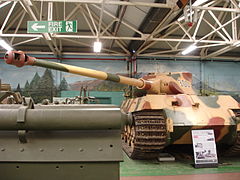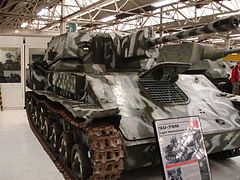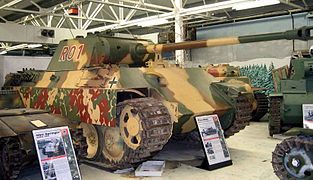The Tank Museum
| File:Logo of The Tank Museum.jpg | |
 The museum | |
| Established | 1947 |
|---|---|
| Location | Bovington, Dorset England |
| Coordinates | 50°41′43″N 2°14′37″W / 50.695194°N 2.243611°W |
| Type | Military Museum |
| Public transit access | Wool railway station |
| Website | www.tankmuseum.org |
The Tank Museum (previously The Bovington Tank Museum) is a collection of armoured fighting vehicles at Bovington Camp in Dorset, South West England. It is about 1 mile (1.6 km) north of the village of Wool and 12 miles (19 km) west of the major port of Poole. The collection traces the history of the tank. With almost 300 vehicles on exhibition from 26 countries it is the largest collection of tanks and the third largest collection of armoured vehicles in the world.[Note 1] It includes Tiger 131, the only working example of a German Tiger I tank, and a British First World War Mark I, the world's oldest surviving combat tank. It is the museum of the Royal Tank Regiment and the Royal Armoured Corps and is a registered charity.[1]
History
The writer Rudyard Kipling visited Bovington in 1923 and, after viewing the damaged tanks that had been salvaged at the end of the First World War, recommended a museum should be set up.[2] Accordingly a shed was established to house the collection but was not opened to the general public until 1947.[2]
George Forty, who was appointed Director of the Museum in 1982, expanded and modernized the collection. He retired in 1993 after which he received an OBE.[3] The museum established its own YouTube channel to teach about the tanks in January 2010.[4] David Fletcher, who had been an historian at the museum since 1982, retired in 2012 and was also appointed an MBE "for his services to the history of armoured warfare".[5]
Exhibition halls


- World War I Hall (Tank Men)
As well as containing the majority of the museum's World War I tanks this hall tells the story of men who crewed the first tanks between 1916 and 1918.[6]
- Featured tanks: Mark I tank, IV, V (one of the few World War I tanks still in working order), IX & Mark VIII "Liberty" tanks.
- Inter War Hall (War Horse to Horsepower)
This hall now explores the rise of the tank and the role of the cavalry on the Western Front.[7]
- Featured tanks: Vickers A1E1 Independent, Peerless Armoured Car & Vickers Light tank, Mark II.
- World War II Hall

This hall displays the biggest section, with tanks from most nations involved in the conflict.[8]
- Featured tanks: Panzer I, III, IV, Stug III, Tiger II, Jagdpanzer 38(t), Jagdpanther, Jagdtiger, SdKfz 251, Somua S35, Comet I, Matilda Mk I, A38 Valiant, Ram Cruiser Mk II, M24 Chaffee, M4 Sherman, M10 Tank Destroyer, M48 Patton, M26 Pershing, T17 Staghound, Hamilcar glider, DUKW, SU-76, T-26, KV-1, L3/33 LF, M13/40, Tortoise, Black Prince.
- Battlegroup Afghanistan

This hall contains the Battlegroup Afghanistan exhibition. The men of the Royal Armoured Corps who have been involved in some of the fiercest fighting since World War Two.[9]
- Featured tanks: Conqueror, Chieftain (which is accessible), Challenger 1 and TOG2.
- Tank Factory
This hall explores the design & technology that goes into making tanks and AFVs. There is a mock production line of Centurions, as well as prototype and experimental vehicles.[10]
- Featured tanks: a T-55 with sections cut out enabling visitors to see inside, Swedish S tank, prototype FV101 Scorpion and various Ferret armoured cars, along with the first M4 Sherman supplied to the British in World War II, and an A13 Covenanter.
- The Tank Story Hall
This hall holds some of the most important tanks and AFVs in history, with a supporting collection housed in a multimedia exhibition. It follows the story of the tank, from its invention in 1915 through the 20th century and into the future.[11]
- Featured tanks: Little Willie (the forerunner of British tanks), Whippet, FT17, Char B1, Panzer II, Tiger 131 (a Tiger I captured in Tunisia in April 1943 and fully restored to running condition by the workshops at Bovington, this is the only Tiger I left that is capable of running under its own power; it was used in the film Fury), M3 Grant, T-34, Panther, DD Sherman Churchill Mk VII, Sherman Firefly, M48 Patton, T-72, T-62 and Challenger 2
- The Vehicle Conservation Centre
The Vehicle Conservation Centre provides cover for more of the collection and puts on view vehicles that had previously not been seen by the public.[12]
- Featured tanks: Charioteer, M41 Bulldog, M103, M60 Patton, T-54, Cold War and Iraqi T-55s, BMP-1, AMX-30, Type 69, Infanterikanonvagn 91, A33 Excelsior, T14 and SU-100.
Gallery
-
German SdKfz 234 armoured car
-
German Tiger II (with early-Porsche turret)
-
American M103 heavy tank
-
Tiger 131 driving during a display
-
British Challenger 1 tank
-
Soviet SU-76M Self-propelled gun
-
British TOG2 heavy tank prototype
-
Daimler Ferret in UN livery
-
British A-9 Cruiser Mk I
-
Italian L3/33lf tankette flamethrower
-
Sherman DD tank showing canvas flotation screen
-
French Renault FT tank
-
German Panther tank
See also
- Tank museums
- Kubinka Tank Museum – Russia
- Musée des Blindés – France
- Military museum Lešany – Czech Republic
- Deutsches Panzermuseum – Germany
- Patton Museum of Cavalry and Armor – United States
- Yad La-Shiryon – Latrun, Israel
- Parola Tank Museum – Finland
- Australian Armour and Artillery Museum - Australia
- Nationaal Militair Museum - Soesterberg, The Netherlands
- Royal Tank Museum - Amman, Jordan
- Other
- United States Army Ordnance Museum
- Polish Army Museum – large collection of Soviet, western and Polish AFVs
- Heartland Museum of Military Vehicles Nebraska, US.
- Ontario Regiment Museum Ontario, Canada
- Base Borden Military Museum Ontario, Canada
- Lists of armoured fighting vehicles
- Tank classification
Notes
- ^ The Musée des Blindés in France has a collection of 880 armoured vehicles, although it includes fewer tanks than Bovington.
References
- ^ "The Tank Museum Limited, registered charity no. 1102661". Charity Commission for England and Wales.
- ^ a b "Museum history". The Tank Museum. Retrieved 10 June 2018.
- ^ "Lt. Col. George Forty OBE FMA". The Tank Museum. Retrieved 10 June 2018.
- ^ "Tank Museum". YouTube. Retrieved 9 January 2018.
- ^ "David Fletcher Honoured". The Tank Museum. Retrieved 20 August 2014.
- ^ "Tank Men". The Tank Museum. Retrieved 10 June 2018.
- ^ "War Horse to Horsepower". The Tank Museum. Retrieved 10 June 2018.
- ^ "Second World War". The Tank Museum. Retrieved 10 June 2018.
- ^ "Battlegroup Afghanistan". The Tank Museum. Retrieved 10 June 2018.
- ^ "Tank Factory". The Tank Museum. Retrieved 10 June 2018.
- ^ "The Tank Story". The Tank Museum. Retrieved 10 June 2018.
- ^ "The Vehicle Conservation Centre". The Tank Museum. Retrieved 10 June 2018.
External links
- Tank Museum website
- Tank100 blog commemorating the centenary of the First World War.
- Tiger Collection blog
- Rio de Janeiro's military vehicle modeling association – photographs inside the museum














